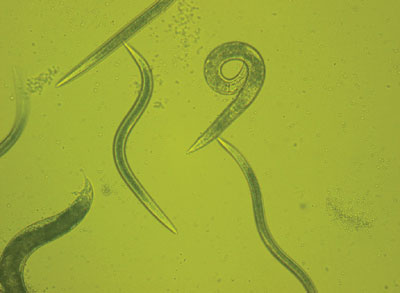| 2006 |

|
YEAR BOOK |
Carlow Institute of Technology
|
What nematodes can do for us!!
|

Findings from a previous research project on the genetic variability and population structure of the entomopathogenic nematode Steinernema feltiae , revealed genetic differences occurring in the ߖtubulin genes in populations of this nematode. The MENR Group are currently testing the hypothesis that Cr VI will cause accumulation of mutations in these genes. �-tubulins are important proteins in terms of cellular structure, cell motility, communication, division and organisation. Disruption to these genes would be damaging to the cell, and ultimately to the organism. Steinernema feltiae is an insect parasite naturally occurring in Irish soils. This project aims to develop this organism, and its genes, into a bioindicator and biomarker system for Cr VI pollution and to study Cr VI induced genotoxicity in this organism.
The Phylum of Nematoda is composed of the most widespread multicellular animals on Earth affecting plants, animals and humans on a global scale. Nematodes occupy key positions as primary and intermediate consumers in soil food webs, and their analysis would offer an in situ or a lab based assessment of soil environment disruptive factors.
Contact: Dr Thomae Kakouli-Duarte,
MENR Group Leader,
Department of Science and Health,
Institute of Technology Carlow.
Tel: 059 9170554
E-mail: [email protected]
Web: www.itcarlow.ie/research/researchers
Stephen Boyle,
MENRG Bioinformatics Laboratory,
Department of Science and Health,
Institute of Technology Carlow.
Tel: 059 9176230/286
E-mail: [email protected]